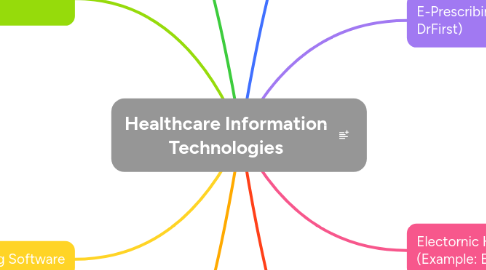
1. Patient Portal (Example: MyChart)
1.1. Easy access to healthcare data
1.1.1. Engage with health records
1.1.2. Look at test results and exams
1.2. Self Served EHR information
1.2.1. Schedule appointments
1.2.2. Make payments
1.3. Positive health outcomes
1.3.1. Improved communication with providors
1.3.2. Refill prescriptions
2. Remote Patient Monitoring (RPM)
2.1. Medical sensors to read body functions
2.1.1. Improved patient care
2.2. Electronically sends data from house to facility
2.2.1. Assists with post discharge care
2.3. Reduced healthcare costs
2.3.1. Less medical errors
2.3.2. Efficiently organizes resources
3. Medical Practice Management Software
3.1. Sends out appointment reminders
3.1.1. Reduces no-shows
3.1.2. Improves patients experience
3.2. Easier access for medical professioansl
3.2.1. Improves operational efficiency
3.3. Automates billing and claims scheduling
3.3.1. Improves organizations financial health
4. Medical Billing Software
4.1. Automatically generates medical bills
4.1.1. Minimizes paper documents
4.1.2. Promotes accurate and secure documentation
4.2. Covers insurance claims/verifications and payment tracking/processing
4.2.1. Allows for effective financial reporting
4.3. Sends out alerts for late payments/pending bills
4.3.1. High-quality patient care
4.3.2. Recieves payments faster by the correct patients
5. Urgent Care Applications
5.1. Allows for patients to track medical care status
5.1.1. Get instant care, and skip waiting rooms
5.2. Tracks patients data that requires immediate attention
5.2.1. Increases patient satisfaction rate
5.3. Provides patients with knowledge about health-related queries
5.3.1. Application provides medical help 24/7
6. E-Prescribing Sorftware (Example: DrFirst)
6.1. Reduce adverse drug reaction
6.1.1. Compares medications
6.2. Avoids medication errors
6.2.1. Alerts medical providers of findings
6.3. Manages and generates prescriptions
6.3.1. Electronic prescriptions
6.3.2. Improves efficiency and communication
7. Electornic Health Records Systems (Example: EPIC)
7.1. Central component
7.1.1. Contains all components of an EMR
7.1.2. Provides a more expansive viw of medical information and treatment
7.2. Patient data can move between facilities and providers
7.2.1. Data stored on a computerized cloud
7.3. Patients official digital health record
7.3.1. Reduces medical information from being lost
8. Master Patient Index (MPI)
8.1. Central hub
8.1.1. Connects registrations, EHRs, and labs
8.1.2. Assigns unique identifiers
8.1.3. Links patient data
8.2. Creates comprehensive medical records
8.2.1. Improves patient security and safety
8.2.2. Imporves care coordination
